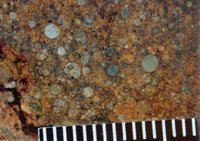Chondrule
|
|
Many meteorites are full of tiny silicate spherules which are called chondrules (from Greek chondros, grain). Meteorites which contain such chondrules are called chondrites. Chondrites consist up to 80% of chondrules, embedded in a fine grained matrix.
Chondrites represent the oldest solid material within our solar system and are believed to be the building blocks of the planetary system. Hence, from the abundance of chondrules within these meteorites, it follows that an understanding of the formation of chondrules is important to understand the initial development of the planetary system.
Chondrules are formed by a rapid heating within minutes or less of solid precursor material to temperatures between 1500°C and 1900°C and subsequent melting, followed by a cooling within a few hours. However, the environmental setting, the energy source for the heating, and the precursor material are not known. The solar nebula or a protoplanetary environment are possible places of formation.
Proposed energy sources are:
- Impact melting
- Meteor ablation
- Hot inner nebula
- FU Orionis outburst of the early sun
- Energetic outflows with bipolar shapes
- Nebular lightning
- Magnetic flares
- Accretion shocks
- Nebular shocks
- Supernova radiation and shockwave
Isotope studies indicate a nearby supernova explosion added fresh material to what became our solar system. The Ningqiang (http://www.geocities.com/~dweir/protected_NING.HTM) carbonaceous chondrite contained sulfur-36 derived from chlorine-36. As chlorine-36 has a half-life of only 300,000 years, it could not have travelled far from its origin. The presence of iron-60 also indicates a nearby supernova. Such proximity implies the radiation and shockwave would have been significant, although the degree of heating is not known.
In contrast, the fine grained matrix, in which the condrules are embedded after their accretion into the chondrites parent body, is assumed to have been condensed directly from the solar nebula.
Organic compounds in chondrites
Most of the organic carbon in CI and CM carbonaceous chondrites is an insoluble complex material. That is similar to the description for kerogen. A kerogen-like material is also in the ALH84001 Martian meteorite.
The CM meteorite from Murchison, Victoria has over 70 extraterrestrial amino acids and other compounds including carboxylic acids, hydroxy carboxylic acids, sulphonic and phosphonic acids, aliphatic, aromatic and polar hydrocarbons, fullerenes, heterocycles, carbonyl compounds, alcohols, amines and amides.
Further reading
- Wlotzka F., Heide F. (1995) Meteorites: Messengers from Space, Springer Verlag, ISBN 0387581057
- Hewins R.H., Jones R.H., and Scott E.R.D. eds. (1996) Chondrules and the Protoplanetary Disk, Cambridge University Press, UK, ISBN 0521552885
- Oliver Botta, Jeffrey L. Bada Extraterrestrial Organic Compounds in Meteorites, Surveys in Geophysics 23 (5): 411-467, 2002
- Vogel N. (2003) Chondrule formation and accretion processes in the early solar nebula - Clues from noble gases in different constituents of unequilibrated chondrites, Der Andere Verlag, Osnabrück, ISBN 3899590554

